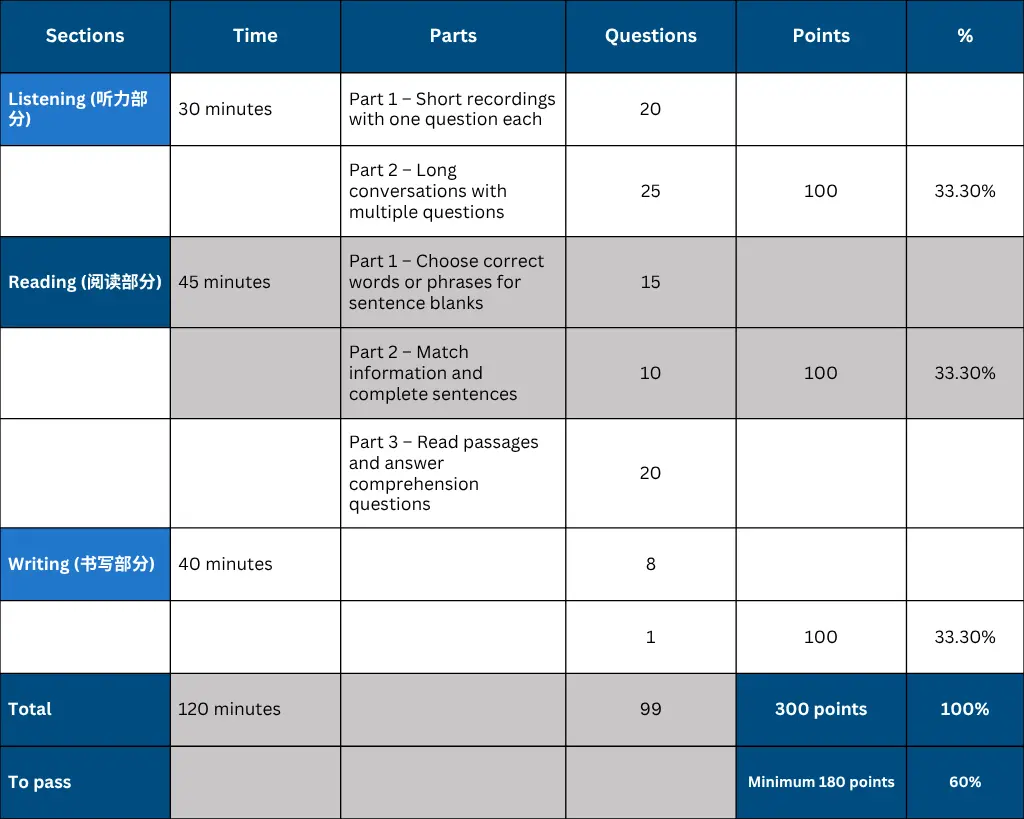The HSK 5 test is part of the internationally recognized Chinese proficiency exam system designed to assess non-native speakers’ Mandarin skills. The term “Chinese Exam” refers to a structured series of tests, known as HSK (Hànyǔ Shuǐpíng Kǎoshì), that measure language ability from beginner to advanced levels. HSK 5 evaluates the capacity to understand news articles, express opinions, and engage in complex conversations.
Exam Structure

The HSK 5 test evaluates advanced Mandarin proficiency for learners who need to read newspapers, follow films, or write clear, detailed texts. Practicing with a Hsk 5 test sample is essential to master the format and pacing. By simulating exam conditions with a real Hsk 5 test sample, candidates improve comprehension, speed, and accuracy across all sections of the HSK 5 test.
Exam Eligibility Criteria
The HSK 5 test is aimed at advanced learners who can comprehend and communicate effectively in Mandarin across a variety of complex topics. It focuses on real-world fluency, requiring candidates to understand news, academic texts, and longer conversations in Chinese. Familiarity with over 2,500 vocabulary words is essential, and reviewing Hsk 5 test questions in advance helps learners prepare for this higher-level challenge.
- No Academic Prerequisites: Anyone can register, regardless of nationality or formal education background. The test is designed for non-native Chinese learners seeking certification of high-level language competence for study, career, or personal goals.
- Minimum Age Recommendation: While there is no official age restriction, the HSK 5 test is generally suited for learners aged 16 and above. The exam includes abstract themes, formal writing, and nuanced grammar, making it more appropriate for mature learners with solid language exposure.
- Language Proficiency Requirements: Candidates should already be comfortable with the content of HSK 4 and demonstrate strong reading comprehension and expressive writing skills. Practicing Hsk 5 test questions regularly is important to develop the stamina and precision required for the test’s complex passages and essay writing.
- Globally Accepted: Whether you’re applying for a university program, Mandarin teaching job, or scholarship in China or abroad, the HSK Level 5 certificate is widely recognized. It’s accepted by Chinese universities, global employers, and even Confucius Institutes worldwide as proof of advanced Mandarin proficiency.
Exam Pattern – Detailed Structure
Chinese HSK level 5 Exam Pattern – Detailed Structure
The HSK 5 test is designed to assess advanced Mandarin proficiency through three key sections: Listening, Reading, and Writing. Each section contains specific task types based on the official syllabus and vocabulary list of over 2,500 words.
Listening (听力) – ~30 minutes | 2 parts | 45 questions
Part 1: Short recordings where test-takers answer a question based on each clip.
Part 2: Longer conversations or monologues followed by multiple related questions. Listening comprehension and attention to detail are essential, and reviewing Hsk 5 test questions helps improve accuracy.
Reading (阅读) – ~45 minutes | 3 parts | 45 questions
Part 1: Sentence-level gap-filling using proper grammar and vocabulary.
Part 2: Matching sentence pairs and reordering them logically.
Part 3: Reading long passages and answering comprehension questions based on content, tone, and meaning.
Writing (书写) – ~40 minutes | 2 parts | 9 tasks
Part 1: Reconstruct sentences using jumbled words.
Part 2: Write an essay of around 80 characters on a given topic. These tasks require familiarity with sentence structure and style, which practicing Hsk 5 test questions can greatly reinforce.
The HSK 5 test format challenges learners to apply language skills fluently and accurately in academic and professional contexts.
Passing Criteria
The HSK 5 test evaluates a learner’s advanced Mandarin skills across Listening, Reading, and Writing sections, each worth 100 points. To succeed, candidates must demonstrate fluency in processing academic texts, structured writing, and real-time conversation comprehension. Regular practice with an HSK 5 Mock Test helps simulate exam pressure and build familiarity with language patterns.
- Score Breakdown:
The HSK 5 test is scored out of 300 points, with Listening, Reading, and Writing sections each carrying 100 points. This equal weight ensures that all language skills are fairly assessed, from comprehension to structured expression. - Passing Requirement:
To pass the exam, candidates must score at least 180 out of 300. There’s no need to excel in every section individually—balanced performance overall is sufficient. Practicing with an HSK 5 Mock Test helps learners target weak areas while reinforcing stronger ones. - Evaluation Method:
Answers are machine-graded for consistency, especially in multiple-choice and structured tasks. In the writing section, essays are assessed for grammar, coherence, and vocabulary use, not for stylistic flair. Regular review using an HSK 5 Mock Test builds accuracy and helps learners meet scoring expectations. - Result Format:
Results are provided with scores for each section along with the total score. A pass/fail status is clearly indicated, offering insight into how well a learner performed across the HSK 5 test components. - No Sectional Cut-off:
There is no minimum score required per section. If a test-taker struggles with one part but performs well in the others, they can still pass—making well-rounded preparation key.
Conclusion
The HSK 5 test marks a significant achievement for learners advancing toward fluency in Mandarin, especially in academic and professional contexts. With its balanced focus on listening, reading, and writing, it challenges candidates to apply language skills in real-world situations. Consistent practice and familiarity with the exam format are essential. Start preparing with full-length mock exams to master the HSK 5 test confidently.